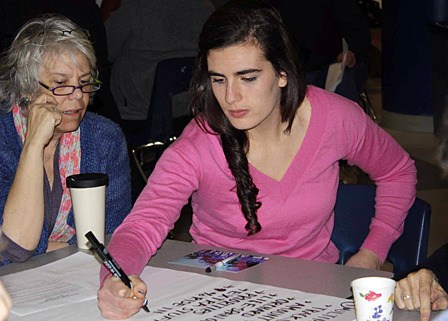Possibly cutting the track and field was an easy enough call, but after that the agony began.
The Orcas School board met on March 11 to decide the fate of a $35 million capital improvements bond rejected by voters in February.
Board member Tony Ghazel urged his fellow board members to consider a smaller bond amount, while board member Chris Sutton was reluctant to cut much beyond the track.
“I just don’t think there’s fluff,” he said.
Board chair Scott Lancaster urged caution.
“We cannot start fudging these numbers that we took four years to arrive at, in a one-hour meeting,” he said.
The board discussed potential reductions to the bond during the arduous two-hour deliberations, but were unwilling to make hasty cuts from a proposal created through years of painstaking research and planning. The proposed project calls for a new middle school facility, including a cafeteria, wood shop, library, music room and other classrooms, and for repairs in the elementary and high schools, old gym and other school property.
The board voted to return the bond to the ballot in August, not April, allowing them more time to hammer out details and to win over the community.
If it had been approved in February, the bond rate would have gone from 37 cents to 72 cents. For example, the new rate would have increased the annual property tax on a property assessed at $358,220 by $179.
The board recognized the following potential cuts: the $2.3 million track, resurfacing of the tennis courts, and new windows for the elementary school building.
They also pondered cutting one room from the new OASIS classroom, square footage from the new cafeteria, one of three planned music practice rooms, the high school fitness room, and a video room, arriving at a total potential reduction of $4.8 million.
Board member Keith Whitaker objected to such internal “corner cutting.”
“Whatever we do, we want to do it well,” he said. “We’ve spent four years figuring out exactly what is needed.”
He raised the possibility of paring off larger chunks, like the old gym, instead presenting it as a capital levy later on, which could drop $1.27 million from the bond.
It was stated that a $5 million cut would allow for a shorter 20-year bond term, saving taxpayers $12 million in interest over the long run compared to the previously proposed 30-year term.
The board generally agreed to the $5 million possibility, but many balked at dropping the amount any lower.
Ghazel strongly advocated a reduced bond, saying the board needs to find a dollar amount the public will approve, and work within that, retaining quality but perhaps reducing square footage. Board member Janet Brownell thought further community education might draw more support.
“I think there’s still a massive amount of misinformation out there that needs to be addressed,” she said.
The board hopes to use the coming months to propagate information and answer lingering questions in the community. They also need time to query school staff on possible areas for reductions.
The decision to go for an August election came on the heels of a community potluck and bond workshop, where close to 70 community members, teachers, board members and high school students broke into roundtable discussions. They answered questions like: What concerns have you heard from those who did not vote for the bond? What have you heard from those people that would make them vote for the bond next time? How can we get more people involved in the discussion of the bond?
Each table reported back to the group at large, with many of the same thoughts:
• $35 million is too much money.
• Cut any items that are “fluff,” leaving only essentials, and addressing the $10 million soft costs.
• Splitting the amount into two bonds might be more palatable to voters.
• Orcas Islanders have trust issues with the school regarding maintenance and spending.
Teacher Mark Padbury asked, “Are we cognizant of the changing demographic of the island? Will we lose families with kids… because they can no longer afford to live here?”
Brownell warned the community about a drastically scaled down bond.
“Every single thing we cut will affect educational programs,” she said.
Audience member Justin Paulsen also worried what kind of results the school would get with a reduced bond. He cited what happened in the 1970s: a $1.7 million bond was approved, after a larger bond was rejected. The result was poorly constructed buildings.
“We got what we paid for,” he said.
Lancaster agreed, and referred to a rendering on display of what the middle school would have looked like if built using the larger bond.
“If it had been built like this, we probably wouldn’t be having this discussion today,” he said.
Whitaker explained the four-year process that culminated in the current proposal.
“This isn’t our plan. This is what we heard from the community, from teachers, and from parents,” he said. “We are again listening, and we are willing to do what the community wants.”
The school board is currently forming an advisory committee that would oversee the bond project once it is approved. David Johnson was just hired as Facilities Manager for the school district, and one of his primary tasks will be to maintain the new buildings, once they are constructed.
Elementary teacher Carrie Schuh spoke passionately about the poor condition of her classroom. She said water from the tap is brown, and the toilets don’t flush properly. The HVAC system is in such disrepair that it’s often 52 degrees in the morning when she gets to class.
“Try teaching a class when you’re all wearing coats and the tiny heaters are blasting,” she said. “Kids deserve to have clean water and running toilets. I am very concerned about next year.”
Editor Colleen Smith Armstrong contributed to this story.



